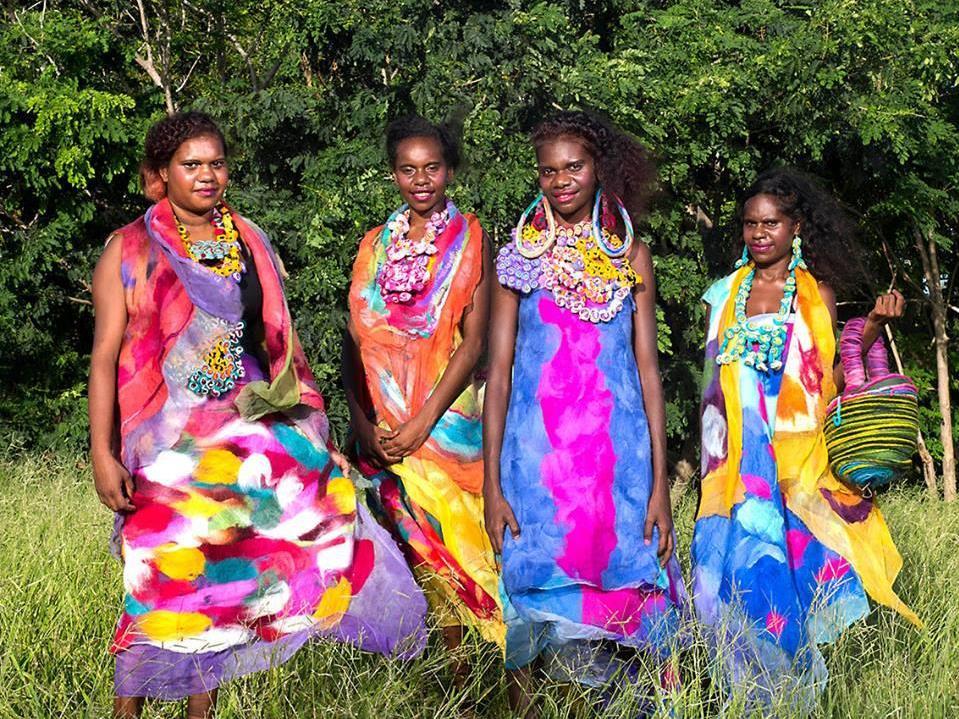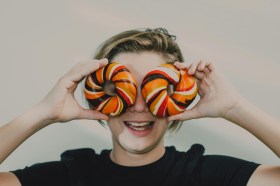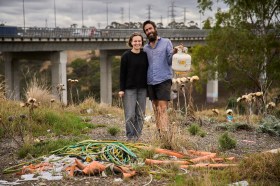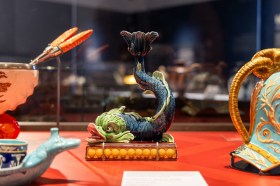Photo by Rhett Hammerton; Stylist: GraceLee; Models Mable Daylight, Letisha Gabori, Rhondell Williams, Alma Williams.
As the peak body for Indigenous art centres in northern Queensland and the Torres Strait, the Indigenous Art Centre Alliance is familiar with the misconceptions many people have about remote arts centres.
Manager Pamela Bigelow said outsiders often did not realise the important role art centres play in their local communities.
‘When I say an “art centre”, it’s such a homogenous word and people think of a gallery or anything they can relate to in an urban centre. Initially people don’t understand that it is a community social enterprise. It’s there to manage the artists’ careers and develop economic outcomes within an appropriate social and cultural context,’ she said.
‘It’s a place of opportunity for people who wish to join it, run by an Indigenous board and is created from a groundswell of need within the community.’
Indigenous art centres are often the only place of employment for the local people in the community, said Bigelow. ‘There are jobs in art centres because we have programs for arts workers. Seven of our art centres are managed by Indigenous people, which is a record across the country.’
Ethical trade
For those who wish to source original Indigenous works ethically, Bigelow says art centres are the right place to start. Purchasing art from an IACA member art centre provides a guarantee that your artwork is authentic and ethically sourced.
‘There is still a commission system. The arts centre takes a commission because they provide everything. It costs to have a manager, a building, art materials, and workshops and all of the things they access. The commission is 40/60 generally, which is the same as a gallery and is the industry standard.’
‘The artists get their 60 percent and then the 40 percent goes back into the art centre into programs and equipment for the artists and art Centre.
Everything is harder
Of course, working in remote communities has its own particular set of challenges that metropolitan (and even regional) arts organisations don’t necessarily understand.
‘Travel costs can be extreme,’ said Bigelow.
‘It costs just as much to go to Erub Island as it does to go to Paris. And you want to bring artists to an exhibition in Melbourne? Everything in a remote community is harder. Supplies, resources, getting arts materials – everything takes time.’
Pair this with the additional time needed to ship work to art fairs and exhibitions and the difficulty these remote art centres face when it comes to internet access, and you can begin to understand.
‘It is a complex world, the art centre world. The manager has to bridge the very elite white art world and the remote, traditional and poorly-resourced communities,’ said Bigelow.
‘Indigenous artists are no different to any artists, they need development, they need help, they need assistance, they need to know what the right materials are and they need to know how to use them. They are not from birth gifted with the ability to create fine art, but of course their cultural background informs them in different ways and we get different outcomes. However it is very much like an artist practice. It’s hard work, it’s long work and it doesn’t just happen overnight.’
Developing art centre autonomy
The 13 art centres that form IACA range in structure and independence. Many of the art centres in Far North Queensland and across the Torres Strait are incorporated organisations run by a board. Currently, only three IACA members are run by a local council but the aim is that these centres will also become incorporated and independent in future.
IACA provides professional development and advocate for the community-based Aboriginal and Torres Strait Islander arts and cultural centres of Far North Queensland.
‘We had two staff that were highly experienced centre managers from other parts of the country who we employed as arts centre development officers who would go out for extended periods of time in an Arts Centre sorting out systems, studios, timetables, teaching and mentoring managers of which we have many new ones.’
Unfortunately, the recent discontinuation of funding for the IACA has meant a reduction to this particular mentorship program.
Professional development opportunities still continue in the form of two conferences the IACA hold each year and ongoing support this body provides to centres that are looking to participate in major events such as the Darwin Aboriginal Art Fair (DAAF).
‘We still do that hands on, one-on-one training as well as the group training, and we also provide professional support in other ways. We provide storage in Cairns, for example, and we support and promote at art fairs and get people there,’ said Bigelow.
And the support is working. Last year alone, the representation of Far North Queensland art centres at DAAF increased from one to eight.





